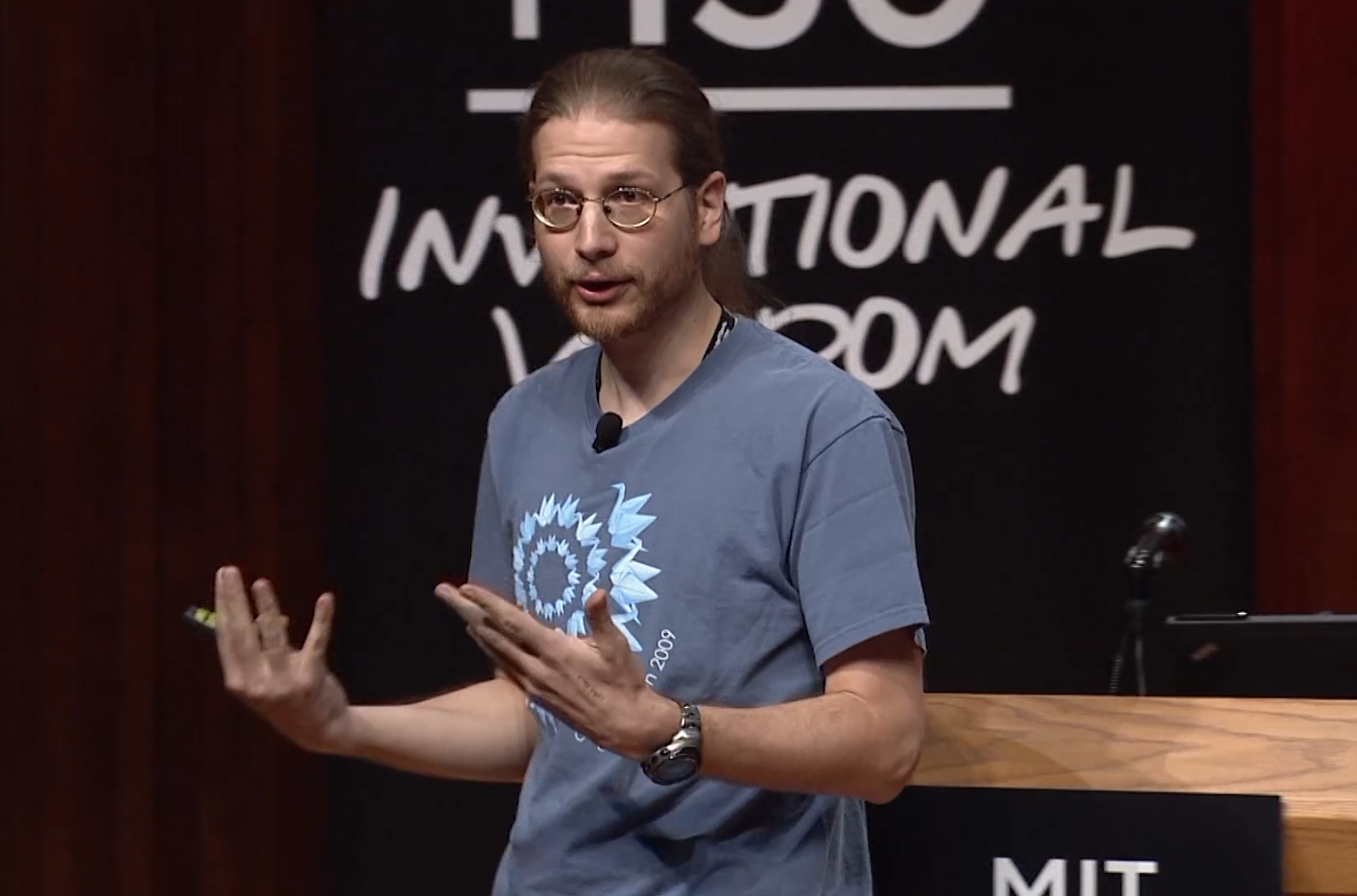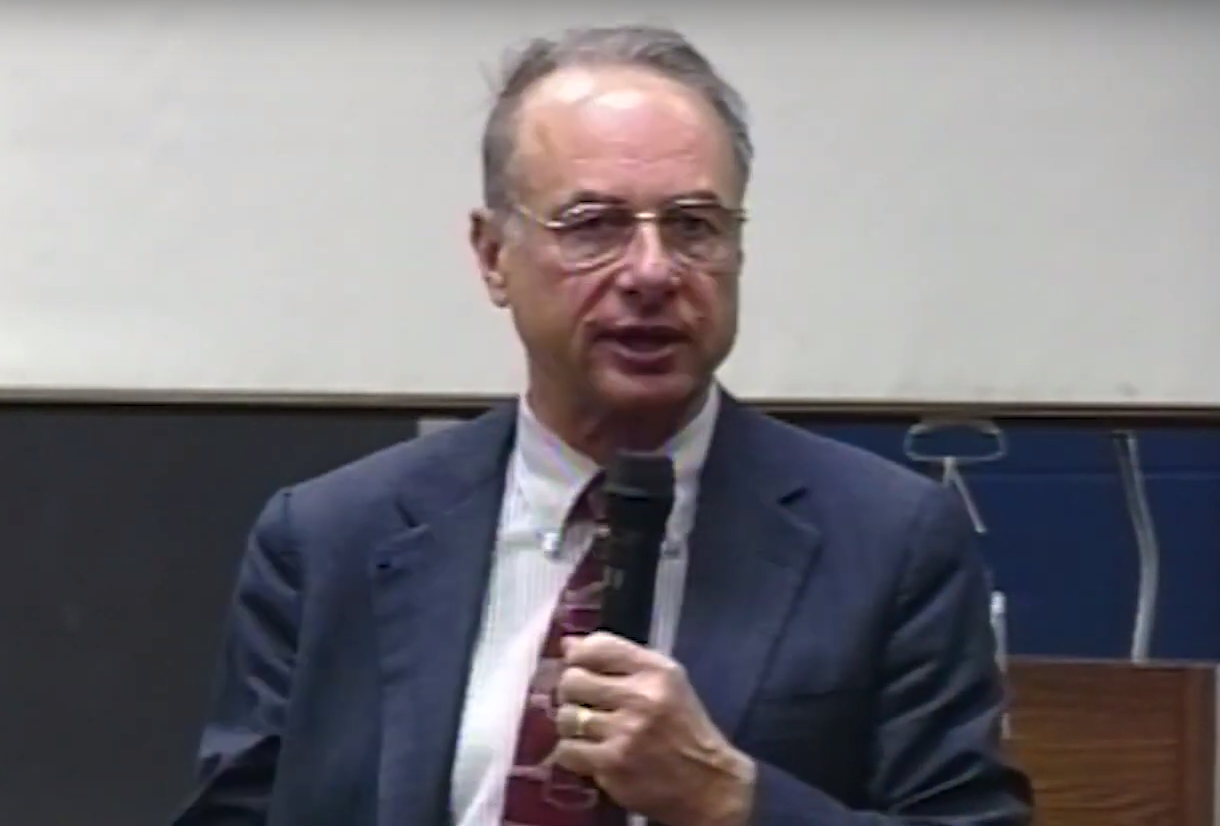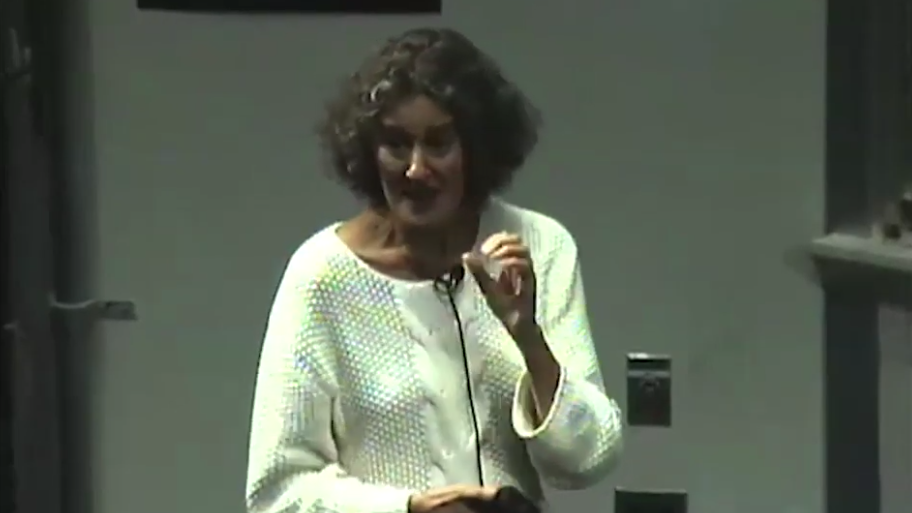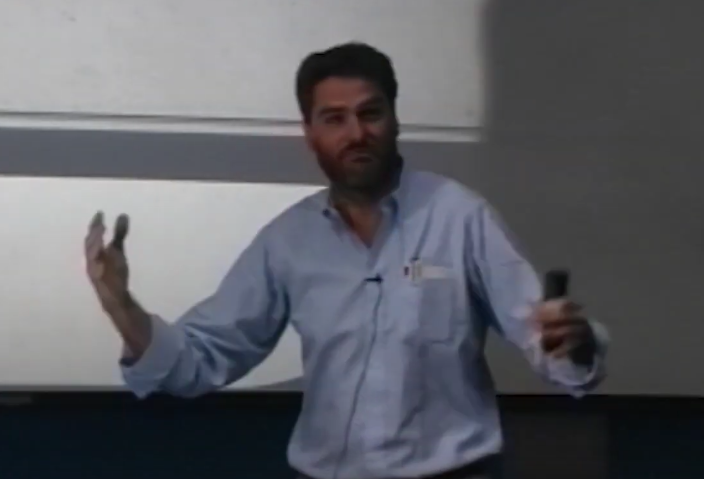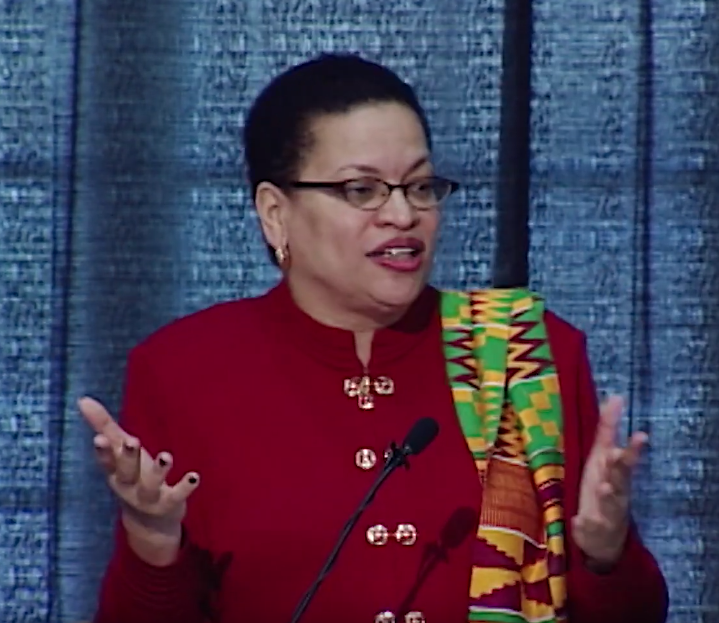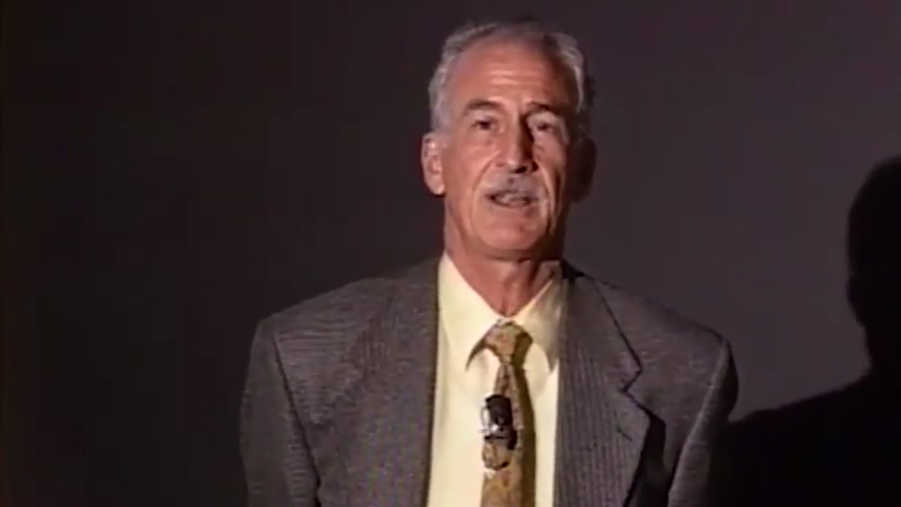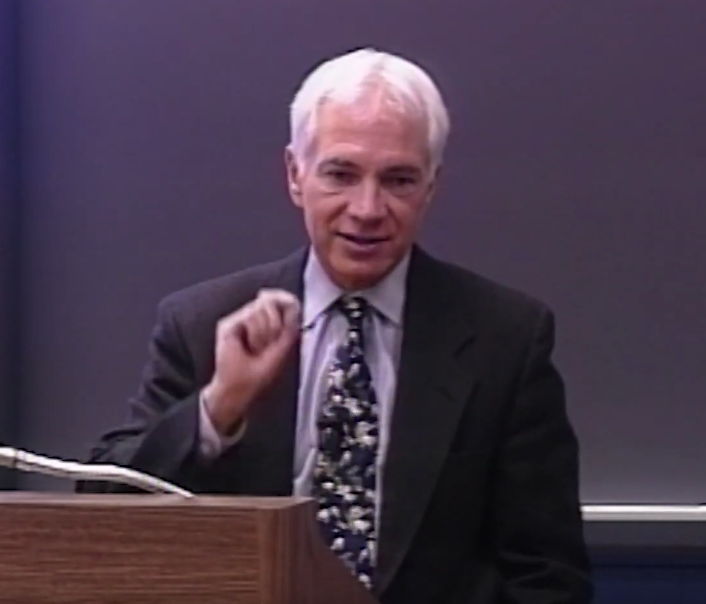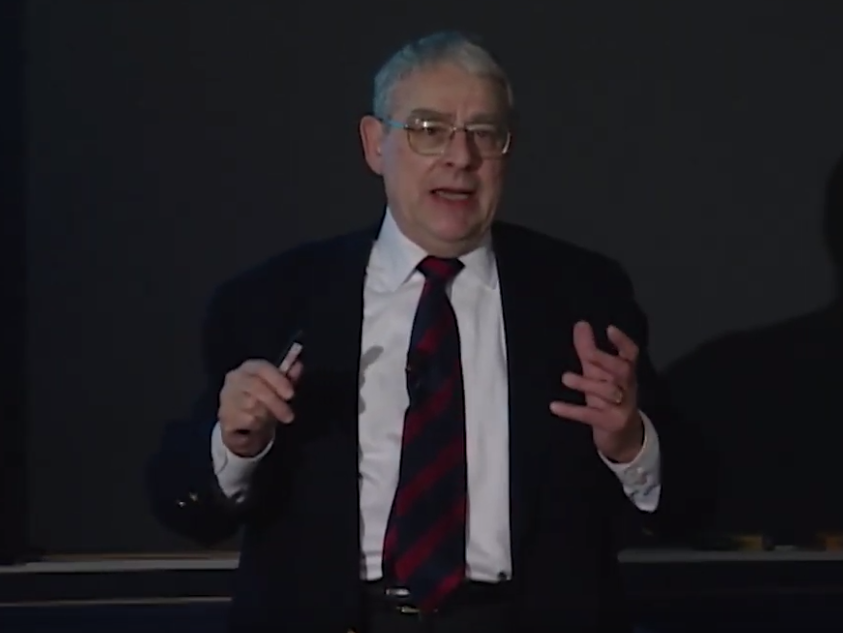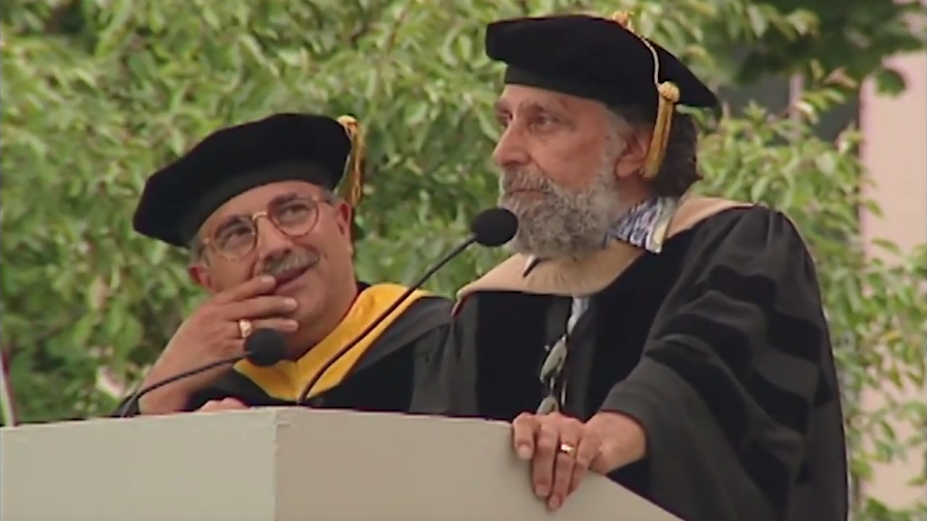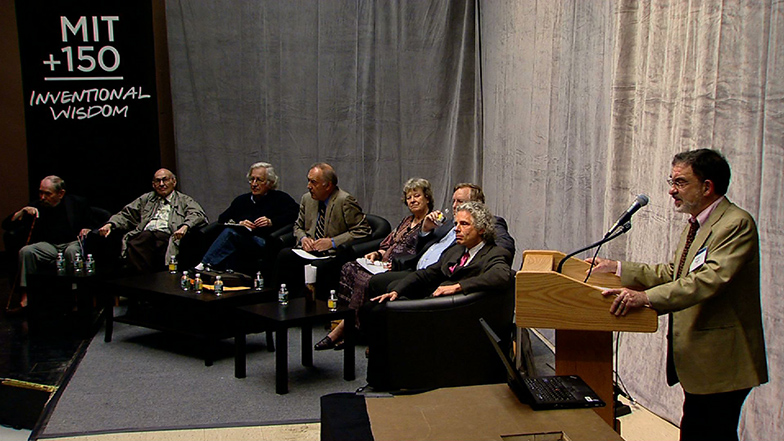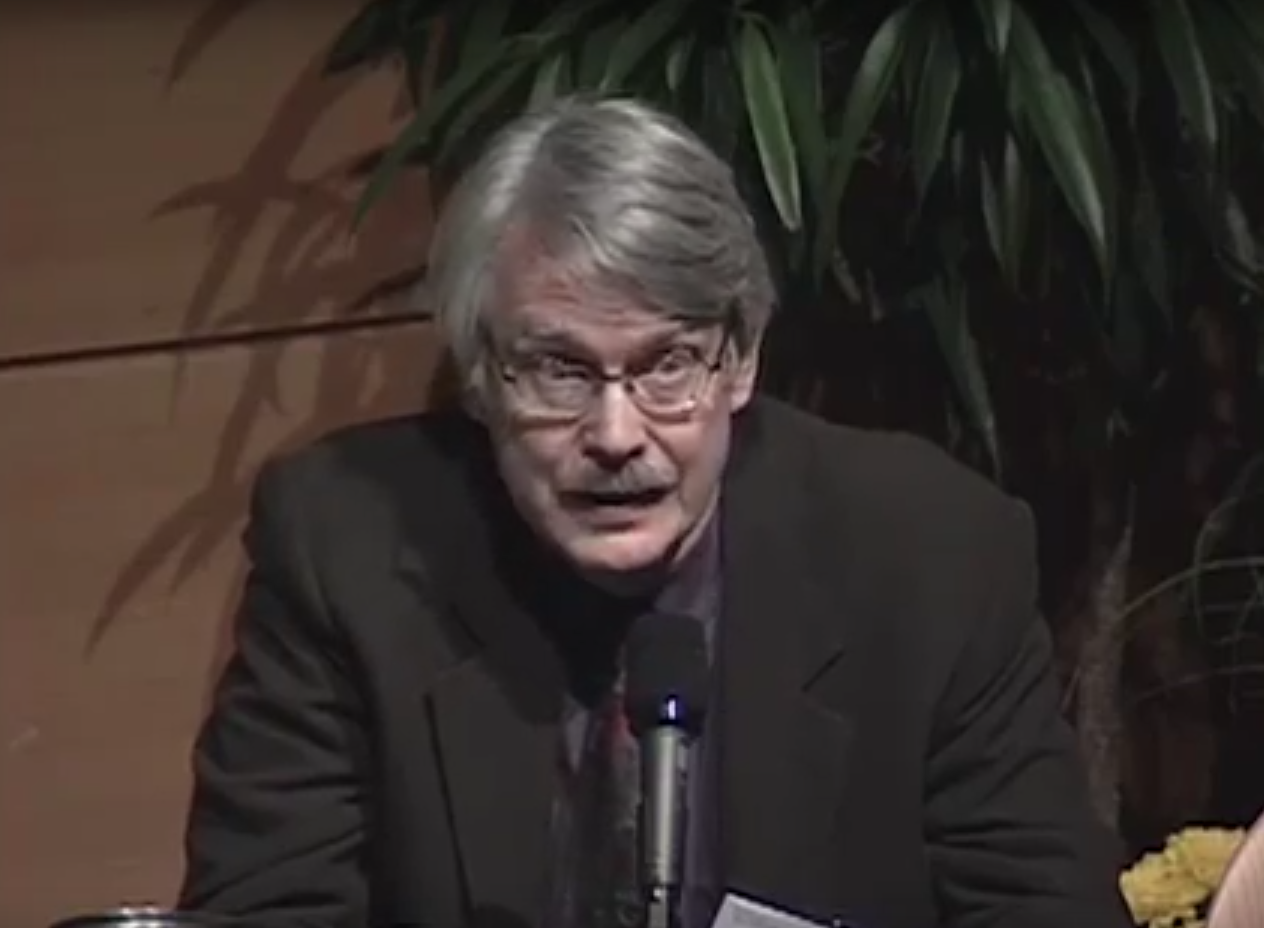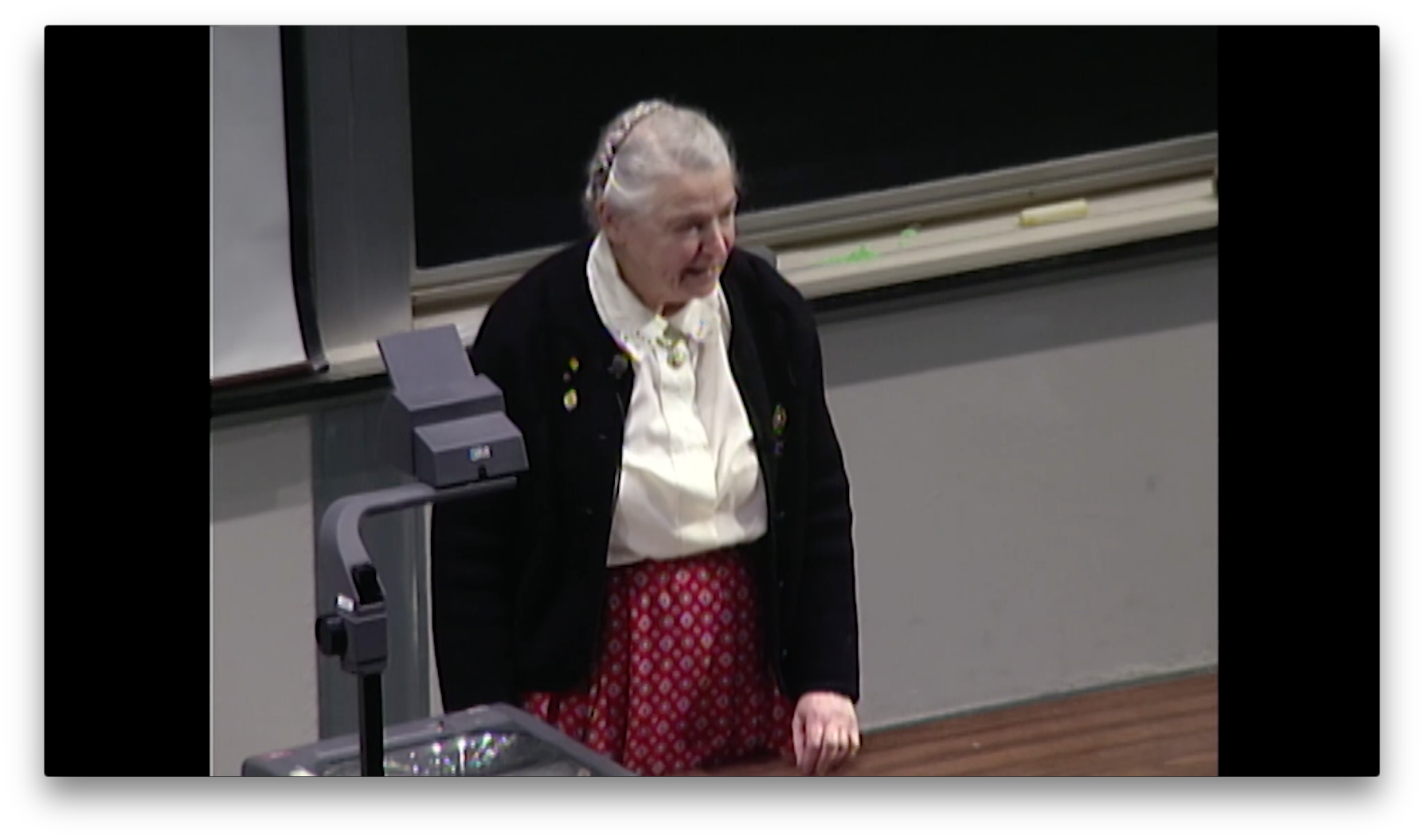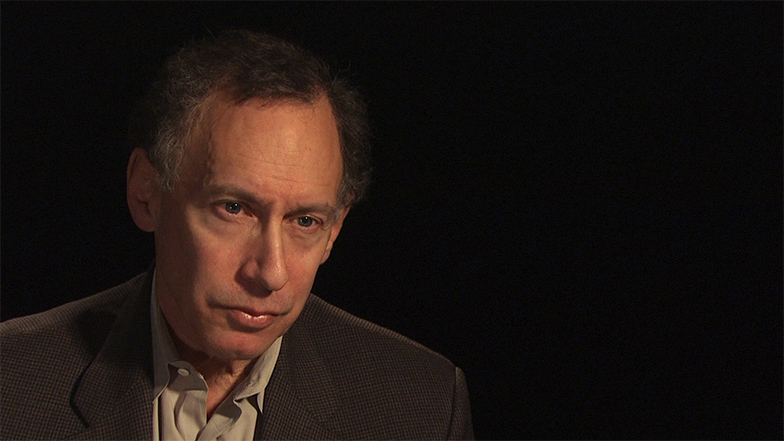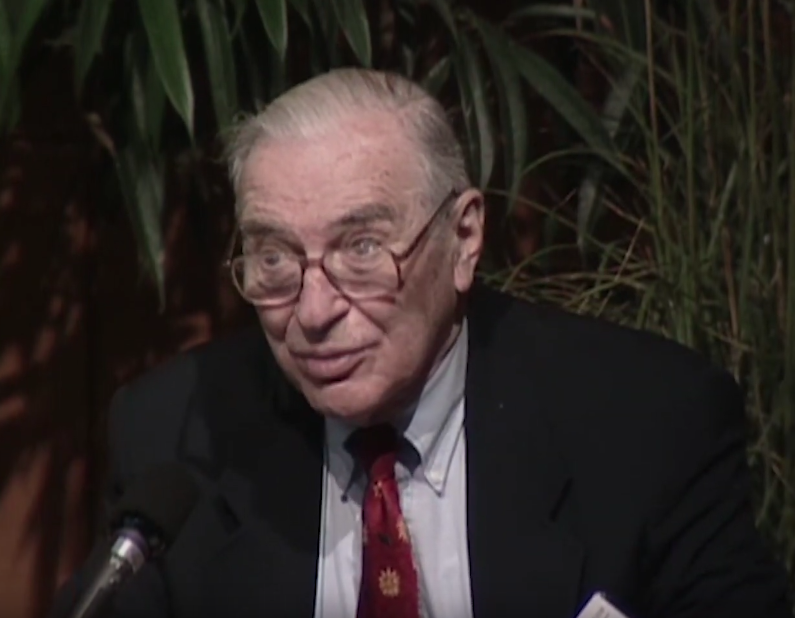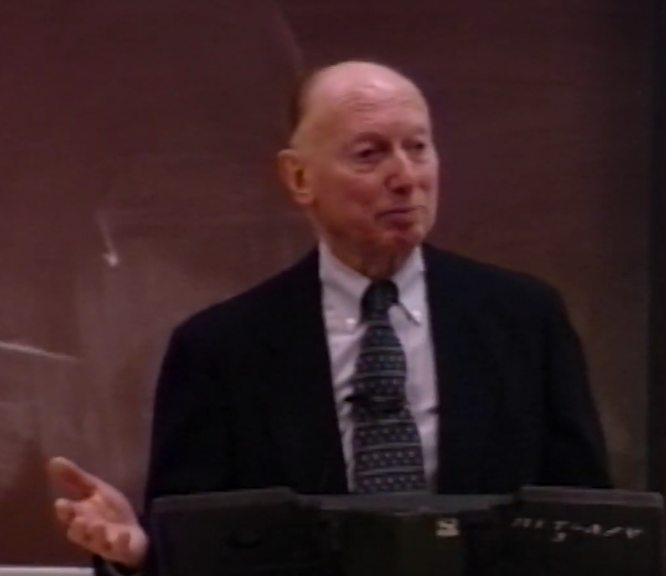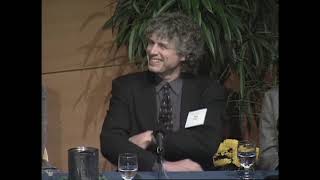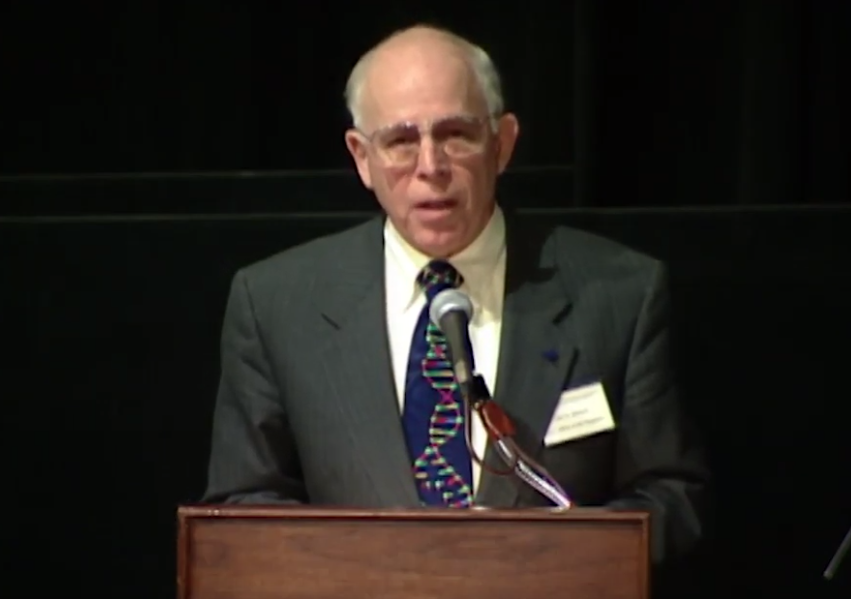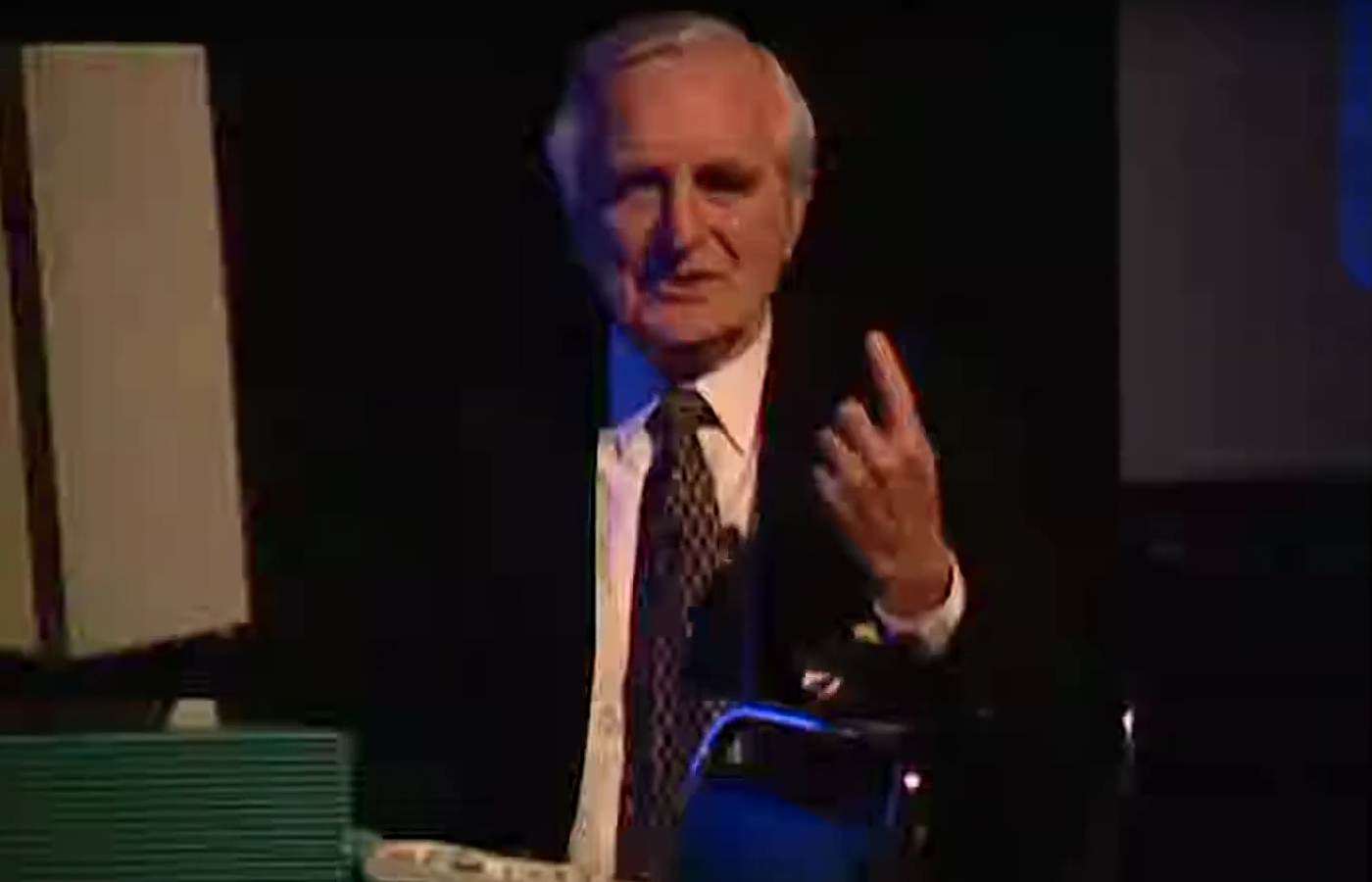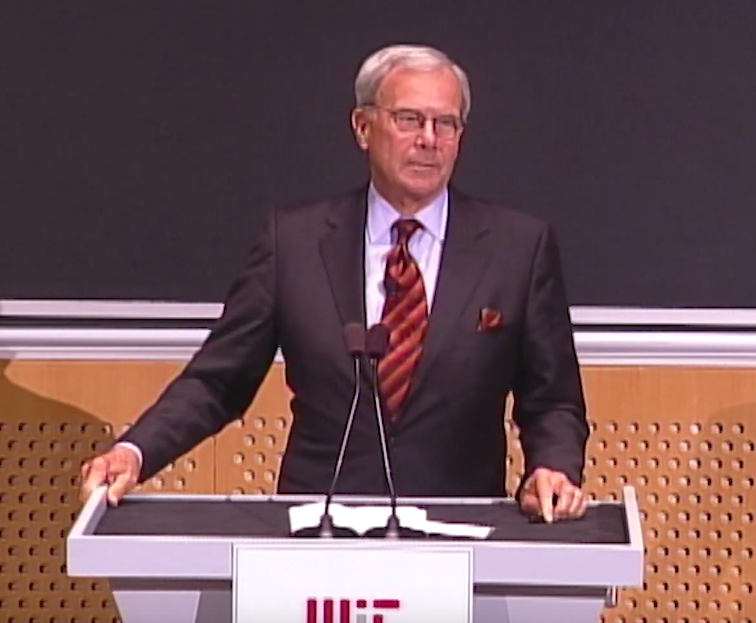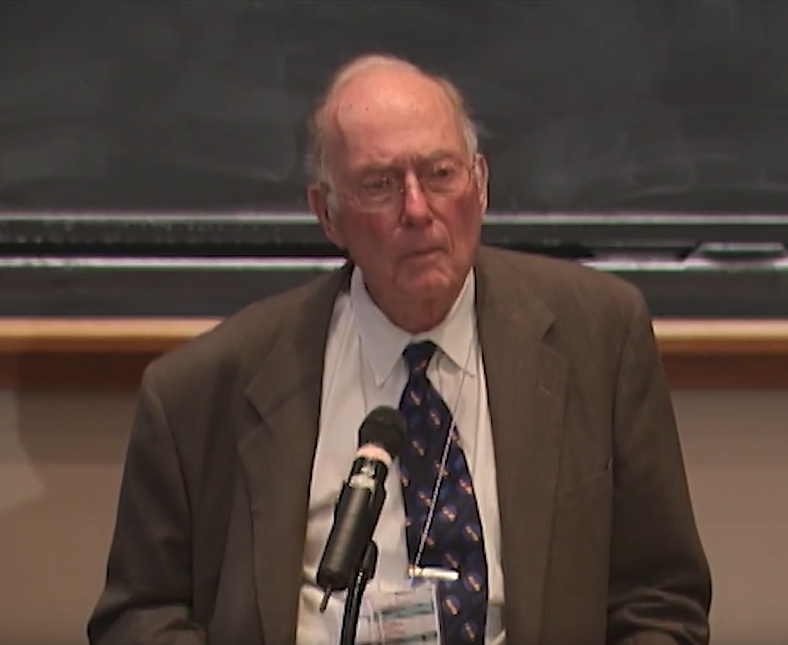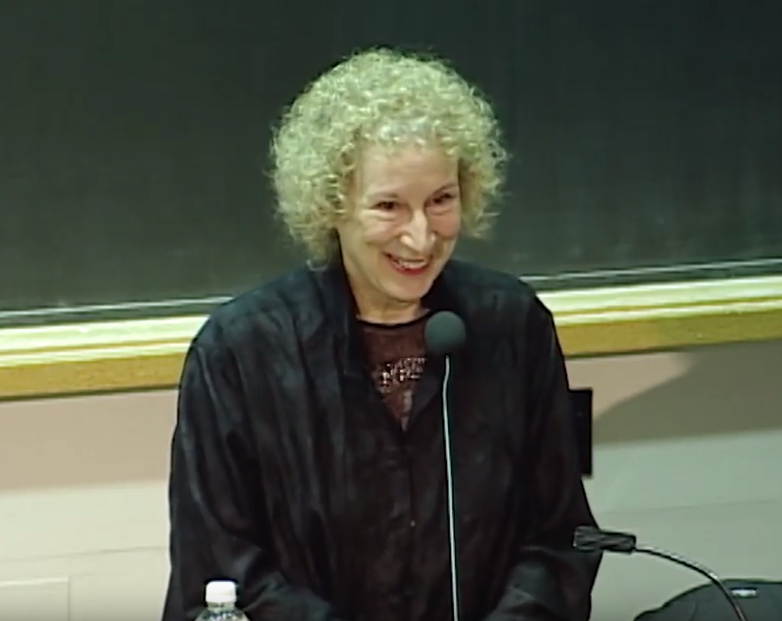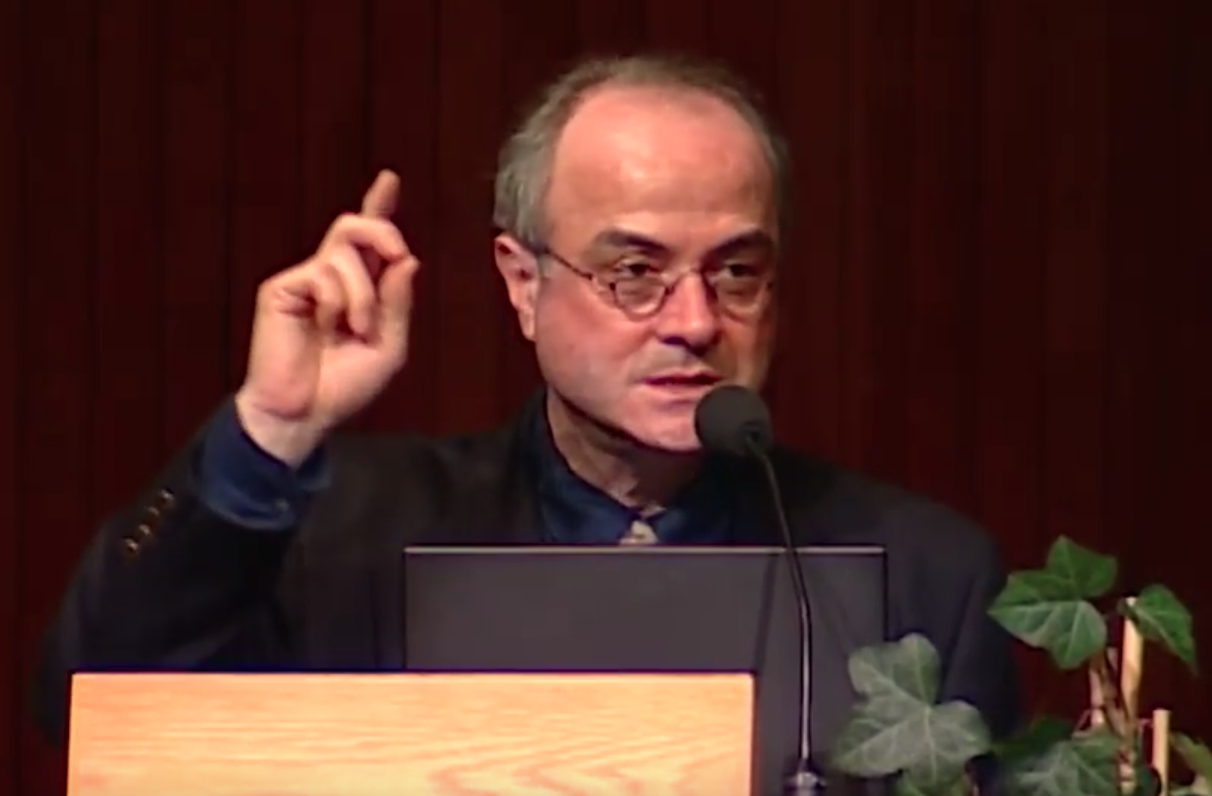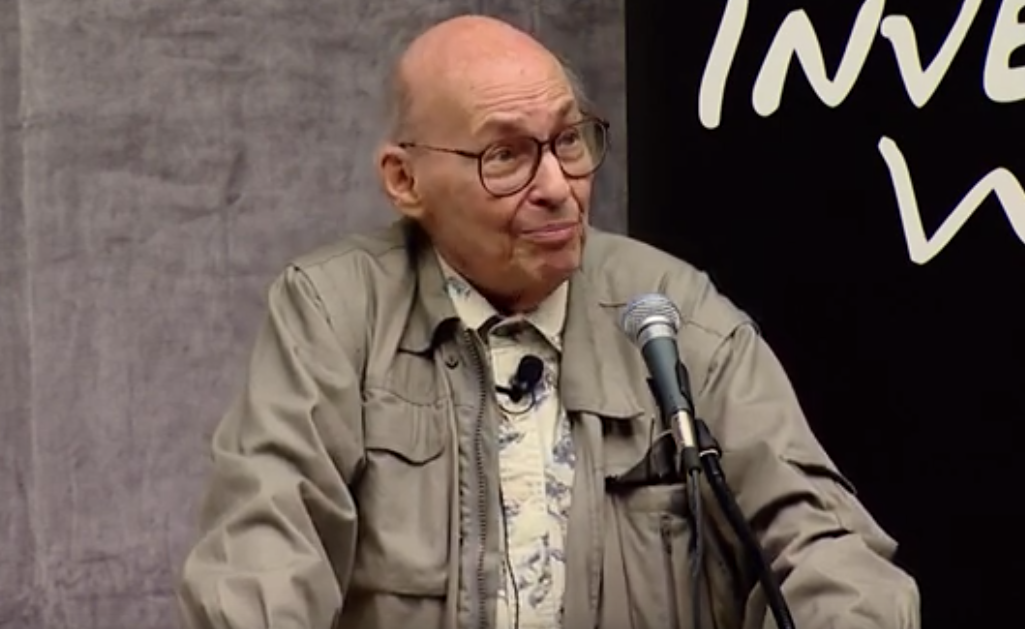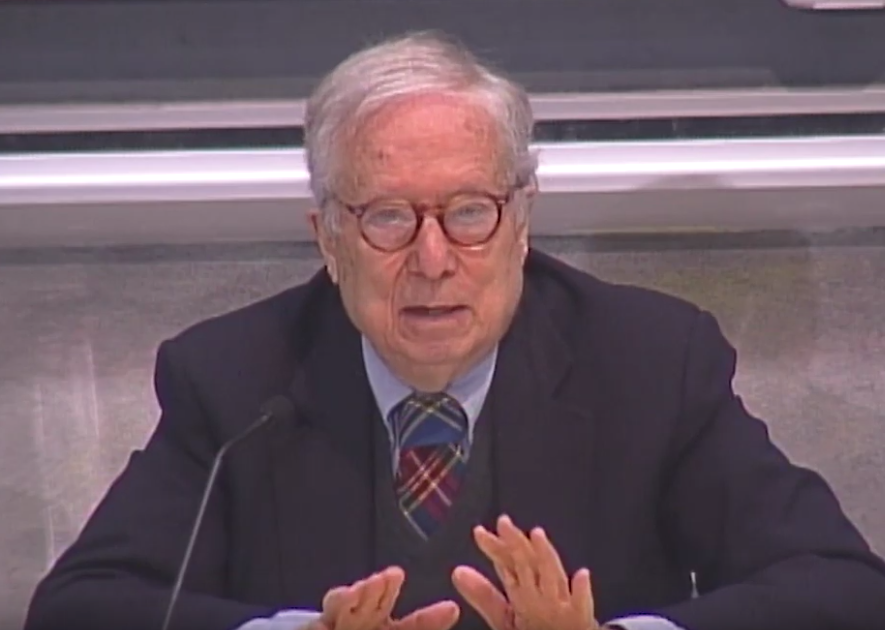15th Annual Killian Award Lecture—Mildred S. Dresselhaus (1987), Lect. 2
[MUSIC PLAYING]
PRESENTER: Second of two Killian award lectures to be presented by Institute Professor Mildred Spiewak Dresselhaus. Let me simply remind you that the Killian award is the highest honor the faculty can bestow on a colleague as a recognition of, quote, extraordinary professional accomplishments and to provide through the lectures a means for the communication of these accomplishments to the faculty, students, other members of the MIT community, and to the general public, thus also-- and I quote-- "honoring the contributions made by Dr. Killian to the intellectual life of the Institute."
To give Millie as much time as possible, I'll say no more about her extraordinary accomplishments-- don't get up yet, Millie-- and her multifaceted contributions to MIT. But we'll simply introduce her second lecture in a series. The overall series is called "New Materials Through Science and New Science through Materials."
The first lecture was entitled "Adventures in Carbon Research," and it was an adventure. And I, knowing nothing about physics, enjoyed the adventure very much. I'm looking forward to today's lecture as I'm sure you are. It's entitled "New Materials and New Science by Intercalation." Millie Dresselhaus.
[APPLAUSE]
MILDRED DRESSELHAUS: It looks as if I frightened quite a few people since the last lecture. I hope those that are here will enjoy what I have to say. Since the last lecture, I had the nicest little note from Dr. Killian, whom you know is in the infirmary.
And thank God that we have high tech. High tech brought the lecture to him in the infirmary and he was able to watch all of this on his screen. He particularly appreciated the remarks I made about Mrs. Killian and her interest in women in science and our women students and faculty and their activities. And as I mentioned in the first lecture, I was dedicating the lecture series to Mrs. Killian and to her memory.
In the morning news today, I heard about this week being National Science and Engineering week. And it seemed that this was a very fitting week to have the Killian lectures as a contribution of MIT to the public understanding of science.
As many of you know, I have strong feelings that scientific and technological organizations should give effort to the public understanding of science and also that the faculty should participate in these kinds of things. So I'm very happy that this happens to be the week for science and technology.
Well, in my first lecture, I spoke about adventures. And I guess that the view graphs are not so visible with the large amount of lighting in the front. Maybe-- that's very much improved.
The first I devoted myself to talking about some of my adventures in carbon research. And today I'd like to talk about something different-- new materials and new science through intercalation.
This is really a talk-- maybe the first one was, also but this is a talk in materials science. My own introduction to this notion of new materials through science and new science through materials came through Professor Arthur von Hippel.
Professor Von Hippel was the dominant figure in the Department of Electrical Engineering and Computer Science for a very, very long time in the area of materials research. And he had some notions that I support 100%.
What he thought was that through science, we can learn about the properties of materials and generate materials that would have properties that we would like them to have. So this is the kind of materials engineering. And it could be said that Professor Von Hippel is the father of our modern notion of materials engineering.
Now to make all of this happen, to have people working on science of new materials, you have to have a collaborative effort between physicists who are doing physics on new materials, chemists who make the new materials, and materials scientists who worry about the processing of materials.
And in his laboratory at MIT, we had a very nice blend, mixture, of people working on all aspects of the same materials to make things as a whole beyond what individuals could do by themselves.
Now that was my inspiration. The implementation came through a different route-- through Ted Geballe, who at the time that he inspired me was a member of the technical staff at the Bell Laboratories. And in 1965, he and a group of co-workers discovered superconductivity in intercalation compounds.
And I was at that time already known as an expert on the electronic properties of graphite. And he contacted me very soon after this discovery to say, gee. We found the most interesting thing. We take carbon in the form of graphite and we add to the carbon alkali metals-- potassium, rubidium, and cesium-- and lo and behold, we get something that superconducting when we know darn well that none of the constituents that we put in there are superconducting by themselves. cells.
This is a very interesting phenomenon perhaps you could do some of these high field magneto-reflection experiments and learn something about what happens to the modification of the band's structure of graphite that promotes superconductivity.
Well, the boundary conditions for doing those experiments were very unfavorable at that time. And we thought about this experiment for a few years, but nothing much happened in the way of implementation until a paper was published in 1971. European Journal.
It was a very, very short paper. But what it showed is that you could see quantum oscillations in intercalation compounds. What Ted Geballe did for me is he alerted me to the field of intercalation compounds. And I started sort of following the literature, and sort of on the back burner.
We weren't really doing anything actively. But when this paper came along, I knew we should get into the business and do something serious. And it was in this way that I got into the study of new materials.
So what is an intercalation compound, anyway, and why do we care about them? Well, an intercalation compound is formed by the introduction of entire layers of guest species into a host material. Suppose the host material is graphite, as in our case here, and we introduce layers of some foreign species like an alkaline metal.
What are the requirements for this to happen? For one thing, it's necessary for the host material to have extremely strong bonding so when the guest species is introduced it doesn't mess up the layers of the host material. And of course, that's satisfy in graphite. And the interplanar binding is very weak so that it's easy to introduce whole layers of a foreign species into the host material.
Now there are, in fact, a number of different host materials that will work. Graphite is only one of them. Transition metal dichalcogenides. You can have there semiconductors. You can have metals. That whole class of materials will accommodate intercalation as many other materials. So there are a whole bunch of host materials and there are also a whole bunch of intercalants that could be put into each of them.
Now the connection between this and materials engineering is clear because by selectively selecting what you put into the host material, you can change, say, the transport properties. You can take a material-- let's say the transition metal dichalcogenides-- semiconduct or introduce materials into between the layers and make the whole system conducting.
Or in the case of graphite, you could increase the conductivity by more than an order of magnitude. Or you can put in a magnetic species, taking the host material that was not magnetic at all and make it magnetic, or introduce in the layers superconducting elements and make material superconducting, et cetera.
So there is a whole variety of things that can be put in. And that gives you an opportunity to tailor the graphite to make layered materials and isotropic materials with diverse properties.
Now why is graphite so interesting? Why graphite rather than the other host materials? Well, for a physicist, the main attraction of graphite is symmetry. That when you introduce the intercalant into graphite, it goes into the graphite in an ordered way in the following sense that the separation between sequential layers of the intercalant, shown here as the red, dashed lines-- the spacing between these is a fixed number of graphite layers and that fixed number of graphite layers is called the stage.
With all the other host materials, the staging phenomenon is not a very well-established periodicity. But in the case of graphite, it is a well-established periodicity, and it allows us to do some rather sophisticated experiments. So that's the reason we got into the study of the graphite interpolation compounds.
Now, one way of thinking about this-- and for the next few minutes, I will focus on the simple property that you could think of the intercalation compound in a superposition principle. We often think-- in electromagnetic theory, we use the superposition principle for many things.
But also in material science, we often have occasions where we have superposition. Here we have a superposition of a package consisting of two graphite layers between which the intercalant is contained.
That's one element. That element, when it occurs in a stage 1 compound or in a stage n compound, has the same separation. It's always the same package. The graphite layers themselves retain the same in-plane spacing and the same spacing between layers. So we could think of that as the second element.
And all we're doing is playing building blocks. We take this package and the graphite layers and we stack different amounts of each together depending on the stage. So in that sense, the intercalation compounds are very simple.
AUDIENCE: How are these materials prepared?
MILDRED DRESSELHAUS: Oh, I don't have a view graph how they're prepared. I should have taken the one along. Obviously, I should've. Well, there are many ways to do this. The simplest way is vapor transport, where you take the intercalant in one part of an ampoule and you have the graphite in another part of the ampoule, and then you maintain a small temperature difference with the graphite at a slightly higher temperature. And voila-- the gas phase seeps into the region where the graphite is, penetrates between the layers, and then you have an intercalation compound.
AUDIENCE: Control the number of stages?
MILDRED DRESSELHAUS: By the vapor pressure. And the temperature difference, which is another way of saying the same thing.
Well, our inroad into the intercalation business was, as I said, through the magneto reflection experiment. That's what we really started out to do back with Ted Geballe back in 1965. That's what we had been talking about. But it took a long time to do this.
Well, the magneto reflection experiment-- yes, I really should say, I said before that I had become well-known for my work in graphite. But it wasn't only that I became known about it for scientific reasons. I also became known about this for sociological reasons.
And this makes too good a story not to tell on an occasion like this, so let me just tell how I caused the blackout of 1965. I think that's how Ted Geballe really found out about me more than the science.
It so happened then on November 9th at about 5 PM, I was running an experiment at the Magnet Lab and I was the only one there. It was me and the operators. And just about the time that we were at peak field, we had two generators running at the time.
We were at peak field and watching these oscillations coming. And we were working on graphite. And the oscillations were coming in. And all of a sudden, the oscillations started going wild. And our recorder pan that showed the magnetic field started going wild from 0 all the way to-- well, we must have been at that time about 12, 13 tesla. Going wildly back up and down between 0 and 12 or 13 tesla.
Well, we had been instructed at the Magnet Lab-- I'd been working at the Magnet Lab already about five years at that time. And I knew when a disaster like that came, the thing to do was throw the panic button. I had never done this before, but this seemed like the right time to do it.
So I threw the panic button and I left the room. You know, I didn't want this thing to blow up on me. I went outside and the lights were dimming and dimming. First they were flickering, and then all of a sudden they went out.
By the time I got to the control room at the Magnet Lab, the whole place was in utter darkness. I said, gee, what I had done. I was the only one running the experiment. It could only have been me.
And I looked outside after the whole Magnet Lab was in darkness. I looked out on the street and there wasn't a street light on, either. And I said, look what I've done to Cambridge. I had been using 10% of the power of Cambridge and I put Cambridge in the state of darkness.
Well as you know, we had a very big blackout in 1965 on November 9th. We remained without power for about a day. And I'm told that the birth rate went up noticeably nine months later.
[LAUGHTER]
Anyhow, this was a sort of a precursor of the magneto reflection experiments on the intercalation compounds. And the first set of experiments that we ran gave us results that we couldn't believe. And we tried these experiments many times, always getting the same results.
Basically that an interpretation compound had essentially the same magnetic energy level spectrum as graphite. You can see here the identification of the various magnetic transitions. They're hardly changed. And here is a plot of the resonance's photon energy versus magnetic field.
We did these experiments many materials, many ways. We always got the same results. And we didn't believe it and the public didn't believe it, either. And it was for this reason that we started looking at other aspects of intercalation.
And the first thing that we looked after the magneto reflection was the phonon modes. Phonon modes are significantly different from electron modes. So if we see nothing in the electrons, maybe we should see something in the phonons.
So this seemed like a totally unrelated experiment. Let's see if we see anything in this case that tells us that we've intercalated. Well here again, we got results that were kind of also slightly unbelievable.
The effect of intercalation on the graphitic modes was very, very small. Here we're at about 1,600 wave numbers. Here's the graphite line. This mode, E2 G2 mode. And it hardly changed as we added intercalant. It went up in stage.
However, there was some evidence that intercalation did something and that we had a second Raman line that was upshifted by about 20 wave numbers. And this line increased in intensity as the stage index decreased-- that is, the concentration increased. And finally at stage 2 this first line disappeared, and also for stage 1.
Well, the explanation of this-- we came up with an explanation for this pretty soon. And the explanation is we had a bunch of graphite layers here. That they were very strongly screened from the intercalant layer by a graphite bounding layer.
And when you get to stage 2, all the graphite layers are graphite-bounding layers. There are no graphite-interior layers that are like the graphite. The layers that are just like the graphite give a resonance at the same frequency that the graphite does. But the ones that are on the bounding layer-- they have a lot more charge and they will give an upshifted mode.
So that whole story made sense, even though the effects were minuscule. We learned some science from this. But we also learned from this something about ethics. From this experience, I got a commitment that we have to teach the students, our graduate students, about the ethics of-- it's like teaching your own children about the ethics of how to live. Teaching your students about the ethics of science.
When we did these experiments and presented them at an APS meeting right shortly after we had done the experiments, there was another group that turned out that were doing similar experiments. And when we presented our results, they said our results were totally wrong; that they had done the same experiments and found large changes in the Raman effect.
And, well, the large changes were well-accepted by the community because it had been known that intercalation changes the electronic properties by orders of magnitude. So everybody thought that they were right and we were wrong.
So we sat on our results for a long time. We presented the explanation of our results also at that time. And it was quite surprising when six months later, we still were sitting on our results that we thought were wrong. We found our competition in print with our proposed explanation of the effect. What that tells you is that there's ethics in science, and we have to have everybody practice ethics.
Now we went on and studied the stage dependence of the phonon spectrum and the acceptors is what I showed you in the previous view graph. That the frequency goes up as you increase the amount intercalant concentration, decrease the stage.
And for donor compounds, the opposite occurs. That is, when you increase the concentration, the frequency goes down. Now this is the one that we could understand from what had been done in the literature on measurement of lattice constants.
You have a donor compound charged from the alkali metal. Goes into the graphite layers. It expands the lattice constants. Makes the mode soft. And therefore you have a decrease in phonon frequency. Very, very understandable.
If that's the case, then the opposite should happen in the acceptor compounds-- that the addition of intercalant should sap up electrons. Should take electrons away the graphite layers. Therefore, the lattice constants should contract, and therefore you should have a stiffening of the mode, and that's what's observed.
But the experiments hadn't been done. So a master's thesis was generated and we show that the lattice constant for acceptors and donors behaved in an opposite way and the different magnitudes have to do with the different amounts of charge transfer.
This phononic problem was a lot of fun, really, because it provided some nice problem sets for solid state physics. And I notice a number of people in the audience from my solid state physics class. And you're familiar with these equations for a couple phonons in a solid, 1-dimensional line, the top being for similar species and the second set of equations for two species on a line.
Well, an intercalation compound is really two different species-- and intercalant and graphite layers, each layer represented by one ball. And when you use that model, you get very nice phonon dispersion relations. And just fitting these, you get the constants for the forces. So phonon dispersion relations provided a nice set of examples for the solid state course.
Now how do we understand the experiments in transport? I said that intercalation changes the transport properties by an order of magnitude. And then I said also that the electronic structure didn't change and the lattice mode structure didn't change.
So what changed? Well, what changed was the position of the Fermi energy. I guess the students in the solid state class have heard me say this very often that you can change the properties of a solid greatly by changing the Fermi level, keeping the electronic structure the same.
Well, how does that work? Well, here we have the intercalant, that's the brown, positively-charged atom sitting on the intercalant layer. And if it's an alkali metal, each potassium atom will donate one electron. The electron will go into the graphite layers here.
But most of the charge will go into the graphite-bounding layers, which are right next to the intercalant. There'll be an electrostatic attraction between the two, so we'll develop a very large carrier concentration in the graphite-bounding layers-- very large compared to the carrier concentration in graphite itself, which has almost no carriers. 10 to the minus 4 electrons per atom at room temperature and less than that at low temperature.
So intercalation allows the change in the carrier concentration by approximately three orders of magnitude. So in that way, it's possible to greatly change the transport properties of intercalation compounds.
Now the reason why this whole thing works so well is that the carriers are taken from regions where they have low mobility. For example, a metal like copper normally has a very low mobility-- 35 centimeters squared per vole/second is a small number compared to 13,000 which is characteristic of graphite.
So if you can take the carriers from a low-mobility region and promote them into a high-mobility region, you can really benefit from that high mobility. And that's why an intercalation compound does have a high-- doesn't have a whole lot of carriers, but it has a high conductivity.
In fact, it is said, some people claim they could make compounds that have conductivities higher than copper at room temperature. So now the reason that works, again, with small carrier concentrations is that each carrier has a high mobility.
And exactly the same concept is used in modulation doping of semiconductors superlattices where you have a wide gap semiconductor which you dope, and the electrons will be transferred into these lower energy states into the low-gap semiconductor gallium arsenide where there are no impurities. There are no scattering centers. So that you have the carriers and you have the high mobility and you get high conductivity in that way.
Well, we could also understand from this model-- not much intelligence needed-- that the dominant, important layers in graphite as far as transport are concerned are the graphite-bounding layers. And to maximize the conductivity, you want the largest fraction of this sandwich to be graphite-bounding layers.
That tells you you want to make a low-stage compound. But don't make it too small, because if you make it too small then a large fraction of the sample will be taken up with intercalant layers which don't contribute very much to conductivity.
And just to remind you, what I said here is the graphitic layer is zone-folded to make the different Stages. And all that we're doing here is we're changing the position of the Fermi level as we go along. And that makes the difference between stage 1, stage 2, et cetera, for the different conductivities.
Well, by the time we had done this work, I think that our view was finally accepted by the community. It took several years. The early days, it was almost impossible to get any funding to work on intercalation compounds
And I must say that my earliest work on the intercalation compounds came about through the courtesy of the Rockefeller family. In 1973, I was appointed for the first time the Abby Rockefeller Mauzé professor, and that carried with it as a small stipend.
I tried hard to get some money to do intercalation compounds from the federal agencies. But having a physics background, the referees all always rejected my proposals. This work was good for chemists but not for physicists. So it took a little while before any funding came about.
About four years later, when people in other laboratories showed that you could get enhancements in conductivity of, like, a graphite by intercalation, the funding agencies all of a sudden became quite excited. And it was about that time that I worked about the explanation for transport in a system where the graphitic layers were essentially unchanged from the host material. Everything seemed to come together at one time and we got going.
And at that point, we started developing a broader view of the intercalation compounds. A layered structure is a 1-dimensional and a 2-dimensional thing. Perpendicular to the layers-- which is all that I said up to this point-- we have 1-dimensional physics. And in the layer planes, we have 2-dimensional physics.
The 2-dimensional physics is seeing and study the intercalants. So after a few years of playing around with the graphite, what the intercalant did to the graphite, we started looking at what graphite does to the intercalant. Turn the problem around.
And there are rather interesting things that happen, and I'll be pretty brief with what I have to say. The first thing is that you can have different kinds of structures. Three basic different kinds of structures. One is commensurate. I'll mention what that is. Another incommensurate. And thirdly, discommensurate.
All of these things occur in the intercalation compounds as they do also in interfaces that are grown stable by molecular beam epitaxy. And I'll have something to say about how these different kinds of materials interrelate.
Well, here is a commensurate structure of potassium on graphite. It forms a 2-by-2 superlattice in plane, 2-by-2 meaning that the unit cell this way is twice the length of the unit cell of the graphite itself.
Now why does it form a commensurate lattice? There were two forces that are important. One is that the potassiums or the intercalant in general likes to assume a near-neighbor distance that's almost the same as in its native material. It's a 2-dimensional material and the potential minimum for the attraction of the atoms is almost unchanged from what it is in the pristine material.
However, we have one modulation feature, and that's the graphite, which makes the intercalant want to sit over the hollow of the honeycomb structure of the graphite lattice. Because by doing so, we can pack the 3-dimensional crystal and make a closer packing than any other way.
So just by these geometrical arguments, you could see that there were two things acting. One is the inter-atomic forces and the other is the attraction to the graphite honeycomb lattice.
And in this case, with very small space from the closest packing of the intercalant, we can achieve registry with the graphite. So it likes to do that, and in fact does so in the stage 1 compound.
And to prove that we have that, you do what diffraction pattern. And that's a pretty diffraction pattern-- I had to draw it for you to show you the diffraction pattern for a 2-by-2 superlattice.
Now what we see here also occurs in molecular beam epitaxy when you make a strain layer superlattice. This is exactly the same concept. We have a material with one lattice constant, another material with another lattice constant.
And when you put very thin layers together the material with the small lattice constant will stretch and the material with the large lattice constant will contract so that they form together a system with some kind of compromise lattice constant, which you can control with the grated layer that you put as the substrate.
Now this strain layer superlattice, of course, has a big impact on semiconductor technology. Because in the early days of molecular beam epitaxy, it was thought that you had to have lattice matching between the wide-gap and narrow-gap semiconductors that you put together.
With a straight layer superlattice, of course, you have a great deal of flexibility because there'll be some stretching and stretch and give and you can make almost any material go with almost any other material. And that's greatly expanded our horizons in the superlattice field.
Now getting back to the intercalation compounds, another possibility-- when the nearest neighbor distances are totally unmatched to the graphite substrate, then they don't pay any attention to the graphite substrate at all and they just do their own thing and they form layers that are just like layers in the host material.
Here we see cobalt chloride and graphite. So here's a graphite layer. Here's a cobalt chloride tri-layer sandwich where the lattice constants of the cobalt chloride are exactly the same as they are in native cobalt chloride.
But there are several differences between this and what happens in molecular beam epitaxy. For one thing, there is an orientation, a locking of the internal and with respect to the graphite. That is, the intercalant doesn't go in any which way, but it has some preferred directions where it can stay away from the graphite layer in a maximal sense.
The other thing that happens that's different from molecular beam epitaxy is you have atomically sharp interfaces. Just to show you how things are in molecular beam epitaxy, here is the case for the semiconductors. So here's silicon and here's nickel filicide. Now that forms a very nice commensurate structure very much like potassium on graphite.
But here's a situation of an incommensurate structure of germanium with barium fluoride where the lattice consonants are sufficiently different that you don't form a nice interface, and the interface is mushy and corresponds to several atomic distances.
However, for intermediate cases where the lattice constants don't differ by that much, you can form something that's called a discommensurate phase where locally you get phase-matching. You have good registry between the two materials. But because the lattice constant here is significantly smaller than the lattice constant up in here, you have to have extra planes.
And the extra planes are what's called discommensurations. Now sometimes these disconnects discommensurations form periodic structures all in themselves. And when that happens, it's called the stripe domain phase. And I'll say something about that.
We stumbled on this whole thing, whole field, in a very unexpected way. Shortly after we got into while looking at phonon spectrum and intercalation compounds, we found out that in the bromine system you could look both at the graphite motes and at the intercalation modes separately.
And what that meant was that we could monitor, say, phase transitions, looking at what happened and the bromine layer, and at the same time, we could look independently at what happened in the host layer. And then by changing the temperature of the ideas, that we could see something associated with melting. We were really looking for melting of the bromine layers.
So here's a Raman spectrum of the bromine stretch mode in a bromine intercalation compound. And it's a nice lorentzian line for a while. And then the line shape seems to change and we go, all of a sudden, it disappears.
And the disappearance of the line corresponds to a melting transition. But before it melted, we had a line change. Why should there be a line change? A shape change in line shape? At room temperature, the line shape is lorentzian, which indicates that you have a homogeneously broadened line.
But then when the temperature went up just by a few degrees-- 345 degrees, for example-- no more lorentzian line shape but Gaussian line shape, which indicates inhomogeneous broadening.
Now what could have caused that? Well, from the Raman spectrum, there would be no way to decipher that. So we went to our good friend Bob Birgeneau and asked if he would like to do some structural work and see if there was something funny that happened in the bromine system.
And in so doing, we came upon the striped domain phase. I'd say a little bit about this. What the striped domain phase allows us to do is to take the bromine layer and allow its lattice constant to increase above that which would be-- it would have it was commensurate with the graphite on a macroscopic scale. While at the same time, locally, there would be a commensurate registry between the bromine layers and the graphite.
and now that's done by having a domain. Within this domain, we have a commensurate phase. And then there's a wall where the bromine is more dilute, less dense, so that the average lattice constant then will be larger.
And by having the number of unit cells-- capital N-- decrease as the temperature is increased, then the average lattice constant with bromine could grow. So that was the idea of this-- that's the idea of the striped domain phase.
The physical basis of why it occurs in graphite is that graphite has essentially no lattice expansion whatsoever. And anything that you put in any intercalant will have a normal lattice expansion, so it will grow.
And as it grows, it wants to accommodate itself to a larger lattice constant. It stays commensurate for a while. But afterwards, it decides that this is no fun and it goes into this striped domain phase.
Now, the evidence for this comes from some very beautiful work that was done in Birgeneau's group. Here's the crystal structure. Here's the bromine molecules registered on graphite. This is the room temperature commensurate phase for bromine molecules per unit cell.
In the direction of this large part of the unit cell, seven times the graphite lattice constant. That's the direction in which the striped domain phase gets established.
Here are the diffraction spots shown schematically. The triangles correspond to the graphite spots. So between these two graphite spots, we divide the unit into seven equal parts and we put spots-- these spots here are the spots of the superlattice. And they're equally spaced for the case of the commensurate unit cell.
But after we go above this temperature, 342 degrees where we started seeing this Gaussian line shape and the Raman spectrum, these spots are no longer divisible by this distance. But they move in the direction of the arrows firstly by little amounts, but always in this ratio given by this code.
Now, the fact that they move in this prescribed manner and the incommensurability which is related to the reciprocal of the domain size, the fact that this incommensurability has a unique temperature dependence which depends on the reduced temperature to the one-half power-- this and the motion of the spots are an indication or a signature for the onset of the stripe domain phase.
Since initiating this work, Bob has gone on to do some very elegant work using synchrotron radiation where he's followed these transitions in great detail and has studied the melting transition. And I've always felt happy that I've introduced him to intercalation compounds because he's done some very nice work in fundamental science of 2-dimensional systems as a result of this introduction.
The magnetic phase transitions in intercalation compounds are also extremely interesting. And the main thing that we'd wanted to do in this system is a goal that still is unaccomplished. But I'm still hoping that in a short time this goal will be realized. And this is the observation, some kind of direct observation of magnetic vortices in 2-dimensional systems.
Now we haven't done that yet but we have managed to see some very elegant, very interesting magnetic phase diagrams. Many, many magnetic phases, and making use of the high magnetic fields. And I thought that this would be a good time to give a plug for the National Magnet Lab without whose facilities this work would not have been possible.
The system I'd like to talk about is europium in graphite. And europium is a 4f metal that's magnetic. And the spins in the europium will couple rather strongly to the graphite where you have a lot of conduction electrons.
And depending on the ordering of the spins in the europium layers, you get different kind of scattering in the graphite layers. So we could see magnetic phase changes by monitoring either the, say, the magnetization-- that's one thing. But what I'm going to show you here are results on conductivity measurements.
And this turned out to be a very sensitive and kind of a fun experiment. It's kind of nice for this kind of presentation to hopefully some non-experts in the audience, as well as experts.
Here, we have transport properties. Resistivity as a function of magnetic field. And you see glitches. You see big changes occurring as a function of magnetic field.
Each of these glitches-- I put a little red dot-- shows a magnetic phase transition. This one here in particular, this is the z-axis magnetic field and current directions. You could see that what we're plotting here is different temperatures. Each scan is taken at a different temperature and you can almost see the magnetic phase diagram pop out at you just by looking at the transport data.
Well, taking each of these temperature sweeps, and this is temperature here, and going up in temperatures make dots for all of these things, and you develop a magnetic phase diagram. That's simple enough. But what is the explanation of what the spins are doing? That's a little bit more difficult.
And there were two things that were done here. There was a model calculation done by Date in Japan. And we did a Monte Carlo simulation which identified what these various spin states are.
And there was a little bit of new physics that came from this. A little bit unexpected. In magnetism course and basic solid state course, we always teach that the Heisenberg Hamiltonian that controls the magnetic interaction in a magnetic system is a quadratic form between adjacent spins. And then we go second neighbors, third neighbors, et cetera.
But with a Hamiltonian like that, you get nowhere with this phase diagram. You need to have some higher-order terms, these bi-quadratic terms and 4-ring spin terms that show up in a triangular lattice.
These things had been predicted but there had been no real observations. But for this system, in order to get the ferrimagnetic phase, the one with the two spins up and one spin down, it's necessary to have the terms in the blue and the red. And that was a new piece of physics.
The reason they're so big is because we have spin a half. Europium you know is a half-filled shell, and that makes it kind of interesting.
I should point out and remarked that these experiments were made use of the highest fields available. We went up to the maximum. We use the hybrid magnet for these experiments. And that was kind of a new experience. We enjoyed that very much.
Well, superconductivity is where we started with the intercalation compounds, and that's where I'm going to finish with the intercalation compounds so we have a full circuit. And the bottom line about superconductivity and intercalation compounds is that intercalation, or the layering process, enhances superconductivity.
Now we have two pieces of evidence for this that are compelling to me. One is that you can make something superconducting where the constituents are neither are superconducting. And that's the case of the alkaline metals. And here's an example of C a K stage 1 potassium in graphite. And that has, oh, pretty low transition temperature. But still, in all, potassium isn't superconducting, nor is carbon.
Now when you take something that is superconducting like potassium mercury, that's an interesting system. It has a transition temperature of about 1 degree Kelvin. You put it in an intercalation compound, instead of 1 degree, you get 1 and 1/2 degrees.
So for systems that are not superconducting, you can make them superconducting. And systems that have a low transition temperature, you can enhance it. So that's an interesting point. So superconductivity in intercalation compounds is something that is worth trying to understand.
However, there are things about it that are unexpected. This is an anisotropic system. And you're quite prepared that the critical field will be anisotropic. It should be. And there's a theory for anisotropy in critical field, mean field theory. And it gives a prediction for what the angular dependence of the critical field should be in terms of a parameter HC2 parallel for theta equals 0 when the field is along the z-axis, and HC2 perpendicular when it's at right angles.
And the problem is that in the intercalation compounds, the ratio of these quantities hC2 perpendicular to parallel is not independent of temperature. It's supposed to be independent of temperature, but it isn't. Experimentally, it's found not to be.
Also, the temperature dependents of HC2 doesn't follow this mean field value. This mean field curve predicts that HC2 should go in linearly. Should have a linear dependence on 1 minus t. t is the reduced temperature close to the critical temperature.
But by the time you're about 6/10 of / little t equal to 6/10, you should start seeing a significant deviations from the linear. So in these two respects, the intercalation compounds show significant departures.
And here's some evidence. This is Allison Chaikin's PhD thesis, or the beginnings of it. And here is a plot now of HC2 versus angle for a temperature close to the critical temperature, and this ratio here is 8.
Then when you get closer to the t equals 0 of reduced temperature 0.3, then this ratio turns out to be significantly larger. Unexpected from the mean field model for anisotopic superconductors.
The temperature dependence of the critical field is supposed to go like this. It's supposed to have saturated at low temperatures. But as low in temperatures we've gone so far, it seems to be linear. Data's kind of noisy, but we're still going way lower than what you would expect for a linear dependence.
So right now we're headed in two directions. Going to higher stages to look for more anisotropy effects. And hopefully to get into the region where the coherence distance will become less than a lattice constant. In that regime, we should have something approaching 2-dimensional superconductivity where we expect rather different behavior from what we have in the region here where the coherence distance is large compared to the repeat distance in the unit cell.
Now this field has become of course, very interesting very recently because of the discovery of the high-temperature superconductors which, of course, are layered compounds and have some similarity to intercalation compounds because we have copper oxide layers here and copper oxide layers here.
And then we have spacer layers. The spacer layers are different things for different compounds. I've shown here a picture of a lanthanum barium series because I know what the crystal structure is for that one. For the 98 degree one, I've seen different crystal structures. And I'm not exactly sure. People don't exactly agree on what the crystal structures are.
But what they all agree on is that there are spacer layers. Well, the spacer layers are a lot like intercalation compounds. Because here we have conduction electrons. That's the graphite. And here we have something else.
And what is the connection? I don't know. But there are other people that think that there's some connection here. Because when Alison was talking about this at the APS meeting at the intercalation session just before her talk started. They had a room that was about like this. A lot of empty seats.
And then when her talk was about to start, people came in through the door. And when her talk was going on, the place was halfway-- was quite filled. And as soon as her talk was over, half the audience got up and left again. So there are people out there that think that intercalation compounds might have something to do with the layering business in the high-TC superconductors.
Well, from a pedagogical point of view, I think that the advent of high-TC superconductivity is a great boon for people in materials research. So many of the big discoveries in the last decade or so have been inaccessible to students.
When MBE came in, everybody knew this was very important but almost nobody had the finances, either the money to buy the systems or the technical support staff to do it. When the scanning tunneling microscope came, it seemed like that also would need some very, very special engineering to make that go. Of course, in a short time, we found out that that was accessible, and now we have scanning tunneling microscopes all over the place.
But many fields of science are quite inaccessible to university people because of the costs. But this is different because most anybody seems to be able to make samples. There are samples all over the place and there are all kinds of measurements that are interesting and exciting. So this seems like a good field to get students excited about solid state physics.
Of course, you know that there are a hundred other people out there doing the same experiment so you better be doing something else for your thesis work. But you can participate in the excitement for a while, and that's a lot of fun.
Now here's a change of area. But to me, it's just a continuum. There are very many things that we would like to make. Many kinds of intercalation compounds that we'd like to make, but we don't know how to synthesize them.
If we could just put in any old, any arbitrary metal in graphite, or, say, with these high-TC superconductors, we can just stuff in a copper oxide layer. If we knew how to do any of these things and put them between graphite layers, we could really do some very exciting science.
And some years ago I had the idea that if we implanted graphite with something and then subsequently intercalated, that we might have some chance of getting things in that wouldn't go by themselves.
Why would that be? Well, if you implant something, you know that with an eye and a planner, you can plant any element in the periodic table. So once you get these elements between graphite layers, it opens up the graphite layers. And then once the graphite layers are opened up, then subsequent addition of an intercalant species should be easy.
Well, we tried this idea and it sort of works. But I think this technology will take a lot of doing and we haven't pursued it to the extent that we should. Now the idea is so we intercalate graphite with some species that either doesn't interpolate at all or intercalates poorly.
So here's a test sample that we implanted here. And this is a protection aluminum foil so that there's no ions going over here. And so we have the reference control specimen. And here is the sample, implanted sample.
And what we do then is we take the sample and put it into our ampoule and we start an intercalation. And we see if there is an enhanced intercalation in the region that's been implanted.
So we have a control sample. Well, I guess is the whole thing. So we have the control sample here that was prepared at the same time, the same intercalation as this one, that half of it wasn't planted. And then we looked with Raman spectroscopy on this side. We have a microprobe so we could look very close to the implanted region.
And we do get an enhancement. This is the graphite-bounding layer. So it shows that we've made it a lower-stage compound in this case, for the implanted case, than for the other case.
Well, we've tried this a little further, but the results have not been as encouraging as I would like. However, I think it's a good idea. I would like to encourage other people to work on it. If we had more time, I guess we would do more on it ourselves.
Last time, I talked about the use of ion implantation as a way to study regrowth in anisotopic materials. And I won't bore you with this again except to say that in so doing, we used annealing as a method of recovery.
So we put it in the ions. We make this awful mess. We introduce a lot of damage. And then we anneal the sample and we anneal out the mess and we try to regrow the system that we started with.
And in so doing, we measure both the temperature dependents and the time dependents. The temperature dependents gives us the activation energy and the time dependents gives us information on the kinetics.
Well while we were doing this, we had the idea, gee whiz. Instead of using furnaces, why don't we try using laser annealing? And so we tried a graphite sample. And part of the laser pulse irradiated the sample with laser pulse radiation with the idea that we would affect some annealing.
Well of course, the opposite happened. It didn't make annealing at all but made more disorder. But when we thought about the disorder, we found out that we stumbled on a very good problem, and that is the laser melting of graphite.
And that's my last topic. And I'll just say a few things about that because I think that's been one of the most exciting things that we've been doing with graphite recently. And it ends up with a big controversy in the field. And it's always nice to end the talk with a big controversy.
Well, the idea of the laser melting-- I mentioned last time that graphite is the highest melting temperature material in nature. It melts at about 4,450 Kelvin-- a very high temperature indeed. So you can't put the graphite in a crucible to melt it because the crucible will melt before the graphite.
So you have to melt the graphite in its own crucible. So here's graphite. And we put a laser beam in and we're going to make a little puddle of graphite inside a graphite wafer.
So here's our laser pulse. What we use-- 30 nanosecond pulses. We have a ruby laser. And the energies-- I don't have even have the photon energy there. The skin depth falls off with the usual skin depth of a few hundred angstroms.
And once we melt the graphite then we have the melt temperature here for a little distance. And here's the melt front. And as we increase the laser energy, the melt front moves into the sample and the laser pulse is turned off. The melt front recedes, goes back to the surface, and we get regrowth. So that's basically what the experiment is that we did.
And where do we sit on the graphite phase diagram? Here's the graphite phase diagram. A very historical phase diagram. The phase diagram of Bundy that has to do with the formation of diamonds.
And so here is the diamond phase that was what the phase diagram was concocted for. But we're over here at a very low pressure but high temperature, and we're going to melt carbon. At least we think we're going to melt carbon.
And we did four different experiments initially to show that you could make liquid carbon. One of them is Rutherford backscattering in the channeling mode. Then we put in ion-implanted markers, Raman scattering, and transmission electron microscopy.
None of these experiments by themselves were especially convincing that liquid carbon had been formed. But taken altogether, there was no way that we could explain all the results without the formation of liquid carbon.
The collaborators in this work-- we had a bunch of MIT people and three people from Bell Labs. [INAUDIBLE], Jacobson, and Gibson. This experiment would not have been possible without the collaboration of Bell Labs and their wonderful facilities.
And I wanted to make one philosophical comment about where I think materials research in the future is going-- that we'll have more and more of these kinds of collaborations because the cost of equipment is going up and up and becoming less and less accessible for university-type people.
On the other side, from the industrial standpoint, people in industry are getting more and more pushed for fast results and relevance of their research. So they are getting more interested in having university people do far-out things. So I see this as a future trend in our field.
A future trend, and I think maybe a welcome trend. I don't think it's a bad trend at all. I think it's maybe a good trip.
Well, here are the four experiments about melting carbon. This is the thesis of John Steinbeck. The first experiment is Rutherford backscattering channeling. If the helium ions that we're using to probe the carbon-- they have a high energy; 2 MeV-- If they're directed along the z-axis, then they don't see the ions very effectively and they'll miss the ions to some degree.
And the scattering intensity, the backscattering, will be at this low level here that I've indicated here by the word channeling. However, when the beam is tipped away from the z-axis by even a fraction of a degree, then there'll be copious scattering of the carbon atoms and we'll be up in this range-- the random range.
Now if we introduce disorder in the crystal-- that is, we don't have a very well-defined z-axis and it's off by a bit-- then we'll go from this channeling level to the random level.
Now there's also a depth dependence that Rutherford backscattering is sensitive to. Why is that? The helium atoms that are scattered from the surface atoms will come back with the maximum energy, but those that get scattered from a carbon atoms at an anterior position will come back with less energy because they lose energy coming to the surface.
So that the energy of the helium atoms, once they come out of the graphite, is an indication of the depth from which they were scattered. So we have a depth scale that we show on the top. Okay. That's all the background that you need to understand the experiment.
Now we zap the graphite with a laser at different levels. And here are the different levels. And it's key-coded on the curves. Initially we stay at the channeling direction. But as the laser energy increases this level, we get some disorder scattering. And the disorder scattering increases as the laser intensity increases and it increases and it increases.
Here, by the time we're 1.2 joules per square centimeter, we have a sharp interface and we get almost a random situation at the surface. That sharp interface moves as we go inside the crystal. The sharp interface suggested that we had melting but we didn't really believe it, so we tried the next experiment which is a marker.
Now here's a marker of arsenic. We're still going to do Rutherford backscattering. But now we'll do backscattering from the arsenic atoms. Arsenic, being heavier than carbon, will deliver backscattered helium atoms at a much higher energy. So that's separated from the energy that we get from the scattering of the carbon atoms.
When the laser energy is 0 or very small, we get this profile from the Rutherford backscattering. As a laser energy increases, you could think of the meltfront moving in from the surface inside the carbon region. Still far from the arsenic implant. So when we're over here, we still retain essentially the same arsenic line.
But as the meltfront approaches that of the arsenic, the arsenic joins in the puddle and segregates to the surface, and we see that effect here. Much of the arsenic leaves as it melts, and the rest begins to segregate to the surface.
So that experiment is highly suggestive of having molten carbon. The Raman experiment similarly can be explained in terms of melting carbon. And so here is 0 before we start the laser radiation.
And after some laser irradiation, in addition to the Raman line, we get a disorder-induced line. And the line widths get kind of broad, indicating we have a rather disordered system.
But as the laser energy density increases, instead of getting more disorder, we get less disorder. The lines sharpen up and we get a spectrum that's closer to that of the graphite. Well, that's explained here in this little picture.
Where initially we make little, tiny-- the material is molten for very, very small time, the rapid solidification forms very small little crystallites. And the little crystallites are in all random directions. So you get a rather disordered system.
But if the molten region is allowed to stay molten for a longer period of time, the little crystallites grow. And in fact, some fraction of these crystallites might be oriented normal to the original crystallites, so we get some interesting results from that. So the Raman scattering experiment also favors-- not compelling, but it's hard to explain it by any other means than we formed molten carbon.
The transmission electron microscopy experiments likewise can be explained in terms of the melting of carbon. Because for the high laser energy densities, we form a ring at the 002 position, indicating that we form crystallites at right angles to the direction of the original carbon. How could that form if we didn't have molten carbon? So that's fairly conclusive evidence that we formed molten carbon.
Now to explain the depth of disorder quantitatively as a function of the amount of laser energy put into the system, John Steinbeck has formed a model. He's solved the diffusion equation, the heat equation, with a driving term having to do with the laser energy that's put in.
And you have to take a lot of effects into account. It's not only melting, but it's also vaporization of the surface because the vaporization point of carbon is very close to the melting point. And when all of this is done, we took two limits into consideration. One is that the liquid carbon is a Ziman liquid, having 4 electrons per atom. So that's a metallic form of carbon. And another form was a semi-insulating forum where the constants of the liquid form were just like that of the solid extrapolated continuously across the phase transition.
Well, it's clear that the metallic carbon fits the results a whole lot better than the solid extension model, which is that of an insulator. However, we're not the only people that are working in this field. When we came up with these results, some of our competitors up the river who are doing experiments like this in the picosecond range believe firmly that liquid carbon is insulating.
In the interim, we've both done a series of experiments. Our experiments seem to say that liquid carbon is metallic. Their experiments seem to say that liquid carbon is insulating. Well, two groups with different results is interesting. And that, of course, attracts a few people into the foray, so now there are six groups that are working on this.
And the score is pretty much even. We have ourselves with the Bell people-- these are the metallic types. Bundy from GE, the man that made diamonds to begin with, he made liquid carbon also and he thinks it's conducting. And the GM people have recently done experiments and wires-- they think it's conducting also.
But the Harvard people have been joined by a group at Los Alamos and a group at Maryland. And so we have three against three. Half think that it's conducting, half think that it's insulating.
Well, life is always interesting when there's a controversy. And this is a friendly controversy. We all talk to each other. We all help each other. But we don't really know what the answer is.
Now, the coward's way out is to look at the phase diagrams. And here are a whole bunch of phase diagrams for carbon. And this gives you an idea of what a mess the field is in.
These are all pretty recent. Most of them are pretty recent. And they're all very different. And if you look at them, you see that there are some people that predict metallic liquid and there's some people that have insulating liquid. And then they have even two kinds of liquids.
So a cowardly way out is to say that there are really two liquid carbons, a conducting and insulating one. But I think that none of the six groups working in the field really believe this. I think down deep we feel that there's only one kind of liquid carbon in the range that we're all looking at, and we're not really sure whether it's conducting or insulating.
Well, these are some adventures in the field of carbon science. And you see that not the whole story is told. There's still many untold stories that will keep generations of students busy. When a student turns in a PhD thesis at MIT, there are two things that we look for, I think, from a philosophical sense.
That the student has broken new ground. That this is something, a new field, a new area, something that's totally different from what went before. And if it's so, it usually leads to more work than we started. And that's what keeps science going forward.
[APPLAUSE]
Questions. Yes.
AUDIENCE: Is it possible to laser anneal diamond?
MILDRED DRESSELHAUS: Is it possible to laser anneal diamond? Yes.
AUDIENCE: --convert it to graphite.
MILDRED DRESSELHAUS: Yes. It does. It converts. It actually converts it into a mixed phase. That experiment was done a few months after we did our experiment. But it was published in a geological journal, so it took us a while to find out about each other.
And it was done by accident. It was done under high pressure in a diamond anvil cell. And they zapped a sample inside the diamond anvil cell and they melted the carbon and it became graphite. And it was an unhappy a thing for the diamond cell, but a good thing for science.
And they thought that they had discovered liquid carbon for the first time. So they were very excited about it.
AUDIENCE: Usually, we think that light doesn't get absorbed by diamonds.
MILDRED DRESSELHAUS: Well, diamond has some small impurities. Diamond-- it's very difficult to make diamond without any impurities. Now actually, diamond doesn't have enough impurities for our taste, because we're trying to do these experiments by implanting impurities into diamond to make it absorbing enough to do some melting experiments.
So for our likes, we would like it to be more absorbing. But diamond does have native impurities that do absorb some light. And that's what did it.
AUDIENCE: [INAUDIBLE]
MILDRED DRESSELHAUS: Well, you would think that the diamonds they use for anvil cells would be pretty good, actually. Because you want them to be strong. But they still will absorb to some degree. I mean, these are pretty intense laser beams. Yes.
AUDIENCE: Yeah. In that presentation, you said that the [INAUDIBLE] for lattices because they tend to contract, they expand. So they make it more technical. So they have different layers. But what I think is in this process, there is some changes in the pervasive force inside those layers. Is there any more that has been done for [INAUDIBLE] forces. Changes in the [INAUDIBLE] forces to match these two layers? Because as we know that Raman [INAUDIBLE] is sensitive to the changes in a core constant.
MILDRED DRESSELHAUS: Yes. Obviously the layers are going to be straight. And if the layers get thick enough, that you can't make the straight layers superlattice. People have-- I don't know that anybody has done a Raman experiment because I guess the straight isn't totally uniform through the entire layer.
Although the layer has to-- the lattice constant has to be preserved. Otherwise the whole thing would crack. So I guess the whole thing would be under some kind of intense strain the thicker the layer gets.
I don't know that anybody has done Raman scattering from the strain layer superlattice. But I would imagine that that's certainly a doable experiment. The experiment probably has been done and one can get a measure of the force constant.
But as long as the thing stays together, then you're just going to measure the force constant for the equilibrium situation. So that's hardly what you're looking for. .
AUDIENCE: But what about the interface layer?
There will be some tension or--
MILDRED DRESSELHAUS: That's right. There is a tension at the interface layer, but it does stay together. However, I'm told that in time if you keep these strain layer superlattices around for a year, or 10 years, for some length of time, a long time, then they come apart. They don't have a long-term stability.
But maybe the ones that have been made in more recent times do stay together. You know that the strain layer superlattice has an old history that the first few years of the strain layer superlattice, it didn't work at all. This is a fellow at IBM was doing it yet and nobody paid much attention to him.
But he not only did it, but he worked out the theory for it. And the credit has gone to other people who made it work more effectively later on.
AUDIENCE: Probably all of this work that's done starting with a solid and melting it.
MILDRED DRESSELHAUS: Yes.
AUDIENCE: The opposite would be to start with paper and pencil to see what you might get [INAUDIBLE] structure.
MILDRED DRESSELHAUS: Yes, that's an interesting thing and a little difficult to do on the Earth. But maybe in an astrophysical entities that's a possibility.
You know that liquid carbon is something, since we'd gotten into the field, we found out that this is a topic of great interest to astrophysicists and to geologists and of all kinds of people that are not solid state types.
AUDIENCE: Do you know the boiling point of graphite?
MILDRED DRESSELHAUS: Yeah, it's not much above the melting point. It's about 4,700k. So we're very close. It's very different from the other group 4 semiconductors-- well, carbon, because I'm thinking of it as a group 4 material-- where the difference between the boiling point and the melting point is a very large temperature difference. But in this case, it's very close. It makes the properties of liquid carbon kind of interesting.
Well, I think we're finished. And we'll--
[APPLAUSE]

